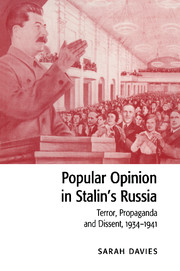Book contents
- Frontmatter
- Contents
- List of tables
- Acknowledgements
- Chronology
- List of abbreviations and archive references
- Glossary and notes on the text
- Introduction
- PART I ECONOMY AND SOCIETY
- 1 Workers, the economy, and labour policy
- 2 Peasants and the kolkhoz
- 3 Women, family policy, education
- 4 Religion and the nationalities question
- PART II POLITICS AND TERROR
- PART III THE LEADER CULT
- Conclusion
- Notes
- Bibliography
- Index
3 - Women, family policy, education
Published online by Cambridge University Press: 25 March 2010
- Frontmatter
- Contents
- List of tables
- Acknowledgements
- Chronology
- List of abbreviations and archive references
- Glossary and notes on the text
- Introduction
- PART I ECONOMY AND SOCIETY
- 1 Workers, the economy, and labour policy
- 2 Peasants and the kolkhoz
- 3 Women, family policy, education
- 4 Religion and the nationalities question
- PART II POLITICS AND TERROR
- PART III THE LEADER CULT
- Conclusion
- Notes
- Bibliography
- Index
Summary
WOMEN AND POPULAR OPINION
In the mid-1930s, the Soviet regime abandoned its earlier ambivalent relationship with ‘bourgeois’ institutions such as marriage, resurrected the ideal of the stable family, and actively promoted motherhood, while simultaneously continuing to espouse sexual equality in the workplace. Women entered the labour force in ever greater numbers in the 1930s. However, in many respects they remained disadvantaged. Gender stereotypes were perpetuated, and women continued to assume almost sole responsibility for the home and family, even when working full-time. How did these circumstances affect women's attitudes? It is often difficult to differentiate the opinions of men and women workers or peasants – a poor working man and a poor working woman shared similar concerns, and many of the opinions discussed in this study were articulated by both sexes. However, the particular burdens of women did shape their discourse, and for this reason it is worthwhile considering in more detail their views, which tended to be oriented more towards questions of byt (everyday life): the home, family, and consumption. Yet it is also important to note that working-class women do not seem to have experienced a solidarity based on gender which might have transcended ‘class’ loyalties, for resentment was expressed towards the ‘middle-class’ housewives feted in the media.
- Type
- Chapter
- Information
- Popular Opinion in Stalin's RussiaTerror, Propaganda and Dissent, 1934–1941, pp. 59 - 72Publisher: Cambridge University PressPrint publication year: 1997



